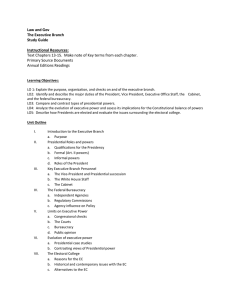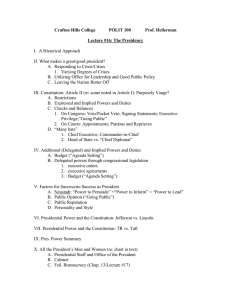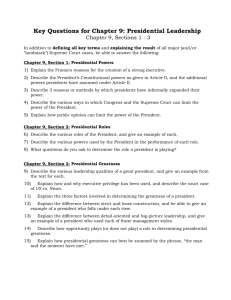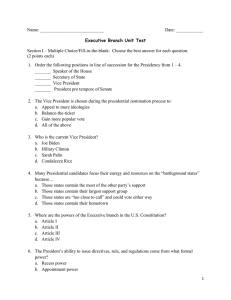Measuring Presidential Power in Post-Communist Countries: Rectification of Mistakes Oleg Zaznaev
advertisement
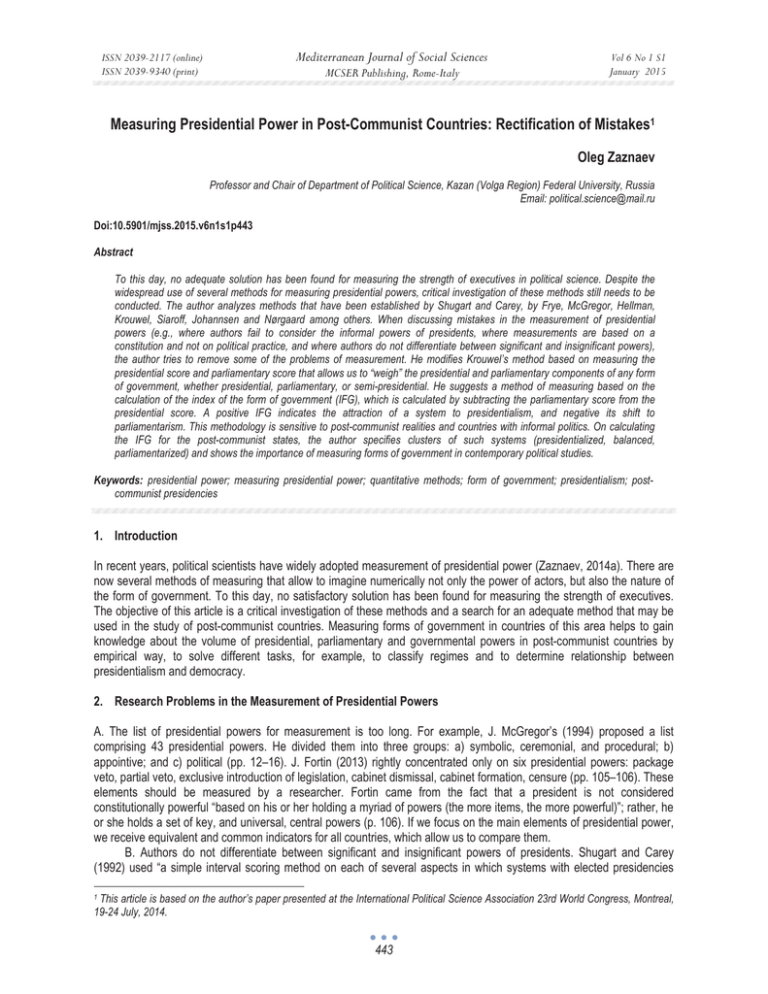
Mediterranean Journal of Social Sciences ISSN 2039-2117 (online) ISSN 2039-9340 (print) MCSER Publishing, Rome-Italy Vol 6 No 1 S1 January 2015 Measuring Presidential Power in Post-Communist Countries: Rectification of Mistakes1 Oleg Zaznaev Professor and Chair of Department of Political Science, Kazan (Volga Region) Federal University, Russia Email: political.science@mail.ru Doi:10.5901/mjss.2015.v6n1s1p443 Abstract To this day, no adequate solution has been found for measuring the strength of executives in political science. Despite the widespread use of several methods for measuring presidential powers, critical investigation of these methods still needs to be conducted. The author analyzes methods that have been established by Shugart and Carey, by Frye, McGregor, Hellman, Krouwel, Siaroff, Johannsen and Nørgaard among others. When discussing mistakes in the measurement of presidential powers (e.g., where authors fail to consider the informal powers of presidents, where measurements are based on a constitution and not on political practice, and where authors do not differentiate between significant and insignificant powers), the author tries to remove some of the problems of measurement. He modifies Krouwel’s method based on measuring the presidential score and parliamentary score that allows us to “weigh” the presidential and parliamentary components of any form of government, whether presidential, parliamentary, or semi-presidential. He suggests a method of measuring based on the calculation of the index of the form of government (IFG), which is calculated by subtracting the parliamentary score from the presidential score. A positive IFG indicates the attraction of a system to presidentialism, and negative its shift to parliamentarism. This methodology is sensitive to post-communist realities and countries with informal politics. On calculating the IFG for the post-communist states, the author specifies clusters of such systems (presidentialized, balanced, parliamentarized) and shows the importance of measuring forms of government in contemporary political studies. Keywords: presidential power; measuring presidential power; quantitative methods; form of government; presidentialism; postcommunist presidencies 1. Introduction In recent years, political scientists have widely adopted measurement of presidential power (Zaznaev, 2014a). There are now several methods of measuring that allow to imagine numerically not only the power of actors, but also the nature of the form of government. To this day, no satisfactory solution has been found for measuring the strength of executives. The objective of this article is a critical investigation of these methods and a search for an adequate method that may be used in the study of post-communist countries. Measuring forms of government in countries of this area helps to gain knowledge about the volume of presidential, parliamentary and governmental powers in post-communist countries by empirical way, to solve different tasks, for example, to classify regimes and to determine relationship between presidentialism and democracy. 2. Research Problems in the Measurement of Presidential Powers A. The list of presidential powers for measurement is too long. For example, J. McGregor’s (1994) proposed a list comprising 43 presidential powers. He divided them into three groups: a) symbolic, ceremonial, and procedural; b) appointive; and c) political (pp. 12–16). J. Fortin (2013) rightly concentrated only on six presidential powers: package veto, partial veto, exclusive introduction of legislation, cabinet dismissal, cabinet formation, censure (pp. 105–106). These elements should be measured by a researcher. Fortin came from the fact that a president is not considered constitutionally powerful “based on his or her holding a myriad of powers (the more items, the more powerful)”; rather, he or she holds a set of key, and universal, central powers (p. 106). If we focus on the main elements of presidential power, we receive equivalent and common indicators for all countries, which allow us to compare them. B. Authors do not differentiate between significant and insignificant powers of presidents. Shugart and Carey (1992) used “a simple interval scoring method on each of several aspects in which systems with elected presidencies This article is based on the author’s paper presented at the International Political Science Association 23rd World Congress, Montreal, 19-24 July, 2014. 1 443 ISSN 2039-2117 (online) ISSN 2039-9340 (print) Mediterranean Journal of Social Sciences MCSER Publishing, Rome-Italy Vol 6 No 1 S1 January 2015 vary” (p. 148) and divided all powers into two groups – legislative and nonlegislative (pp. 148–166). McGregor rightly took into account the “weight” of different groups of powers: appointive powers are twice as important as symbolic, ceremonial, and procedural powers, and political powers are three times as important (p. 10). This is true because, for example, awarding decorations, titles, and honors are not tantamount to the appointment of a prime minister or proposing legislation. C. Measurements are based on a constitution and not on political practice (in the most works). M.S. Shugart and J.M. Carey (1992) focused only on the formal presidential prerogatives, such as those included in the constitution, and did not consider the political practice and the real (not formal) frameworks of power. In my view, this is the defect in their method. A. Siaroff (2003) measured not only the formal but also the informal powers of the president, which thereby makes his method real. He offered a dichotomous indexing system (“1” – yes, “0” – no) and reduced the number of variables to nine (pp. 303–305). Noteworthy here is that two variables in his list (direct election of the president and simultaneous elections for president and legislature) characterize the form of government rather than the actual powers of the president. D. Authors fail to consider the informal powers of presidents. T. Frye’s (1997) method involved dividing the formal powers of the presidency into two groups: the powers “owned” only by the president and those that he performed together with the parliament or the government (shared powers). If the president is elected in a general election, each exclusive power is assigned a value of “1,” and each joint power receives “0.5.” If not elected in this way, all powers receive “0.5.” All of the numerical values are then summed (pp. 525–526). Formal and informal institutions were the focus of L. Johannsen and O. Nørgaard (2003). They offered the so-called Index of Presidential Authority (IPA), which is constructed using three main constitutional power resources – symbolic, appointive, and political. In addition, the IPA seeks to account for the method of presidential election (direct or indirect) and length of presidential term. The president can either possess a power in full (coding “1”), in a qualified form (coding “1/2”), or not at all (coding “0”) (p. 6). Calculation of the IPA is by way of a specially drawn up formula. To what extent does the index of presidential power depend on the president’s personality, and what differences are there between indexes of presidential power, for example, in Russia under Putin or Medvedev. We should consider the formal prerogatives of presidents or informal aspects of presidential authority. So is it necessary to seek the assistance of experts who could say about informal powers. But this is increasing the risk of unreliability. E. J. Hellman (1996) coded the formal constitutional powers of the president depending on the type of regime: in presidential systems each exclusive presidential power received “1,” a power with reservations “0.5,” and not given “0”; in parliamentary systems with direct presidential elections “0.75,” “0.35,” and “0” respectively; and in parliamentary systems with indirect presidential elections “0.5,” “0.25,” and “0”. She explained these differences in coding by the fact that in different institutional structures presidential powers have a different weight. But the question should be addressed: how to compare presidential prerogatives between different regimes? I think that we should not take into account the particularities of presidential, parliamentary, and semi-presidential regimes in the measurement. F. Most authors measure the most likely the president’s powers, not form of government. A. Siaroff (2003) and A. Krouwel (2003) tried to measure form of government. Noteworthy here is that two variables in Siaroff’s list (direct election of the president and simultaneous elections for president and legislature) characterize the form of government rather than the actual powers of the president. A. Krouwel (2003) identified “the core elements of presidentialism,” rather than including all powers and prerogatives of the president (p. 6). How to remove the problems of measurement? I suggest the method that helps us with this. First of all, I would like to turn to Krouwel’s method. 3. Krouwel’s Method of Measurement The method of measurement developed by Krouwel (2003) is, in my view, the most interesting and fruitful. He goes beyond mere analysis of presidential powers to include the “systematic characteristics of political systems as a whole” (p. 6), and sees his task as determining the level of presidentialism instead of a mere measurement of presidential prerogatives. Krouwel adopts a two-dimensional approach (pure presidentialism and pure parliamentarism) and offers a new method based on measuring the presidential score and parliamentary score. He codes the following seven constitutional elements: election of the head of state; dissolution of parliament; ministerial appointments; vote of investiture before a government takes office; vote of confidence; introduction and veto of legislation; and executive powers. In calculating the presidential score, each variable associated with presidentialism receives the score “1,” and each variable that is not a characteristic of presidentialism receives the score “0”; when the powers are shared or limited the score is “0.5” (pp. 16–17). The presidential score is the sum of the scores for all seven variables of presidentialism, 444 ISSN 2039-2117 (online) ISSN 2039-9340 (print) Mediterranean Journal of Social Sciences MCSER Publishing, Rome-Italy Vol 6 No 1 S1 January 2015 and the parliamentary score is the sum of the scores for all seven variables of parliamentarism. The level of presidentialism is then calculated by subtracting the parliamentary score from the presidential score. A positive score indicates presidentialism, a negative score indicates parliamentarism, and the higher the score, the higher the level of presidentialism (p. 9). For example, according to Krouwel, the level of presidentialism for Russia is “+4.5,” for Lithuania “+0.5,” for Poland “0.0,” for Romania “-2.0,” and for the Czech Republic “-4.5.” Krouwel’s method is valuable because it allows us to “weigh” the presidential and parliamentary components of any form of government, whether presidential, parliamentary, or semi-presidential. However, it requires modification. 4. The Modification of Krouwel’s Method of Measurement In particular, I have amended several variables (Zaznaev, 2006; Zaznaev, 2007). I have divided the variable “ministerial appointment” into “appointment of prime minister” and “appointment of ministers,” divided “introduction and veto of legislation” into “introduction of legislation” and “veto of legislation,” and have excluded Krouwel’s “vote of confidence.” Finally, I have added two new variables: “compatibility/incompatibility of the position of member of legislature with the government position” and “formation of a new cabinet after the presidential and (or) the parliamentary elections.” I eventually proposed ten criteria for measuring different systems, whether presidentialism, parliamentarism, semipresidentialism, or any other (Zaznaev, 2006, pp. 192–193). As with Krouwel’s method, the maximum value for each of the 10 criteria is “1,” the minimum is “0,” and there is the intermediate variant “0.5.” Easy to calculate by summing all 10 criterions, the maximum presidential score (PresS) and parliamentary score (ParlS) may be 10 (Zaznaev, 2014a). Table 1: The parliamentary and presidential scores A Criteria Election of the head of state B The executive C Appointment of prime minister D Appointment of ministers E Formation of a new cabinet after… Presidential score 1 – election of the head of state by the people 0.5 – where only one candidate is nominated, he or she is deemed elected without the need for a ballot 0 – the head of state is not elected by the people Parliamentary score 1 – the head of state is elected by parliament or a special electoral college, or he or she inherits the post 0.5 – where only one candidate is nominated, he or she is deemed elected without the need for a ballot 0 – the head of state is elected by the people 1 – the head of state/the president holds the 1 – the executive is the government responsible executive powers and heads the cabinet (the to parliament president’s administration) 0.5 – the executive powers are shared between 0.5 – the head of state/the president shares the head of state/the president and the executive powers with the government government 0 – the head of state/the president has no executive 0 – the government is fully responsible to the powers head of state/the president 1 – the head of state/the president appoints the 1 – the prime minister is appointed by prime minister (or the head of state/the president parliament or the head of state/president who is executes functions of the prime minister) forced to consider the party composition of 0.5 – the head of state/the president shares the parliament power to appoint the prime minister with parliament 0.5 – parliament shares the power to appoint (the coordinated appointment) the prime minister with the head of state/the 0 – the head of state/the president does not affect president (the coordinated appointment) the appointment of the prime minister (or the head of 0 – parliament has no power to influence the state/the president is forced to consider the party appointment of the prime minister composition of parliament when appointing the prime minister) 1 – the head of state/the president alone appoints 1 – the appointment of ministers is the ministers prerogative of parliament and/or the prime 0.5 – the head of state/the president shares the minister prerogative to appoint ministers with the prime 0.5 – parliament (the prime minister) shares the minister and/or parliament (the coordinated prerogative to appoint ministers with the head appointment) of state/the president (the coordinated 0 – the head of state/the president does not affect appointment) the appointment of ministers (or the head of state/the 0 – parliament has no power to influence the president is forced to consider the opinion of cabinet portfolio allocation parliament and/or the prime minister) 1 – the presidential election 1 – the parliamentary election 0.5 – the presidential and the parliamentary elections 0.5 – the presidential and the parliamentary 0 – the parliamentary election elections 0 – the presidential election 445 Mediterranean Journal of Social Sciences ISSN 2039-2117 (online) ISSN 2039-9340 (print) Vol 6 No 1 S1 January 2015 MCSER Publishing, Rome-Italy F Vote of no confidence 1 – a vote of no confidence can be ignored by the head of state/the president and the government 0.5 – a vote of no confidence always results in the resignation of the government or the dissolution of parliament G Introduction of legislation H Veto of legislation I Dissolution of parliament J Compatibility/incompatibility of the position of member of legislature with the government position 1 – a vote of no confidence always results in the resignation of the government (parliament cannot be dissolved in response to a no-confidence vote) 0.5 – a vote of no confidence always results in the resignation of the government or the 0 – a vote of no confidence always results in the dissolution of parliament resignation of the government 0 – a vote of no confidence can be ignored by (parliament cannot be dissolved in response to a no- the head of state/president and the government confidence vote) 1 – the head of state/the president has the right to 1 – the right to propose legislation is only propose legislation, along with parliament (individual vested with parliament (individual MPs, MPs, parliamentary groups) and the government parliamentary groups) and the government 0.5 – the right to propose legislation is vested with 0.5 – the head of state/the president and other the head of state/president, parliament, the actors (judges, electorate etc.) have the right to government, and other actors (judges, electorate propose legislation, along with parliament and etc.) the government 0 – the head of state/the president has no right to 0 – the head of state/the president has the right propose legislation to propose legislation, along with parliament (individual MPs, parliamentary groups) and the government 1 – a qualified majority (2/3; 3/4; 3/5; 4/5) in 1 – there is no veto of the head of state/the parliament is required to override a veto of the head president, or despite rejection of a bill put of state/the president forward by the head of state/the president, it 0.5 – a qualified or simple majority vote in parliament enters into force (and then this bill is passed by may override a veto of legislation referendum) 0 – there is no veto of the head of state/the 0.5 –a qualified or simple majority vote in president, or despite rejection of a bill put forward by parliament may override a veto of legislation the head of state/the president, it enters into force 0 – a qualified majority (2/3; 3/4; 3/5; 4/5) in (and then this bill is passed by referendum) parliament is required to override a veto of the head of state/the president 1 – it is the sole prerogative of the head of state/the 1 – the head of state/the president has no president to dissolve parliament formal powers to dissolve parliament 0.5 – the head of state/the president dissolves 0.5 – the head of state/the president dissolves parliament, but initiated by other actors (the prime parliament, but initiated by other actors (the minister, parliament etc.) prime minister, parliament etc.) 0 – the head of state/the president has no formal 0 – it is the sole prerogative of the head of powers to dissolve parliament state/the president to dissolve parliament 1 – incompatible 1 – compatible 0.5 – compatible for members of one chamber of 0.5 – compatible for members of one chamber parliament and incompatible for members of another of parliament and incompatible for members of chamber another chamber 0 – compatible 0 – incompatible I suggest that my method of measuring is based on the calculation of the index of the form of government (IFG), which is calculated by subtracting the parliamentary score from the presidential score: IFG = PresS – ParlS. A positive IFG indicates the attraction of a system to presidentialism, and negative its shift to parliamentarism. The higher the numerical value of the index, the greater the presidential elements in a system, the lower the more parliamentary. A zero IFG shows a balance of power. All states are placed on a scale of “-10” to “+10.” Therefore, calculating IFG provides opportunities not only for a more accurate estimation of separate systems, but also for comparing them (Zaznaev, 2007, pp. 162–164). Based on this modified methodology, I calculated the IFG of post-Soviet countries. Table 2: IFG of post-Soviet countries 1 2 3 4 5 5 Country Armenia Azerbaijan Belarus Estonia Georgia Kazakhstan Presidential score 4,5 8 8,5 2 7,5 9,5 446 Parliamentary score 5,5 2 1,5 8 2,5 0,5 IFG –1 +6 +7 –6 +5 +9 Mediterranean Journal of Social Sciences ISSN 2039-2117 (online) ISSN 2039-9340 (print) 7 8 9 10 11 12 13 14 15 Vol 6 No 1 S1 January 2015 MCSER Publishing, Rome-Italy Kyrgyzstan Latvia Lithuania Moldova Russia Tajikistan Turkmenistan Ukraine Uzbekistan 7 2 4 2,5 9 8,5 9,5 5 8,5 3 8 6 7,5 1 1,5 0,5 5 1,5 +4 –6 –2 –5 +8 +7 +9 0 +7 5. Measuring Forms of Government in Post-Communist Countries: Pluses of the Modified Krouwel’s Method This method is chosen for the analysis of post-communist world because it is sensitive to realities of these countries. 1. It allows to “weigh” the presidential and parliamentary components of any form of government, whether presidential, parliamentary, or semi-presidential. There is the discussion about forms of government on the post-Soviet space. Using the above-mentioned method, we measure and do not think about the type of government. 2. We can take into account informal politics and informal characteristic of regimes. If we use assessment, we create two tables – formal and informal, for example, in Russia as shown in table 3. Table 3: Presidential and parliamentary scores in Russia Criteria 1 2 3 4 5 6 7 8 9 10 Election of the head of state The executive Appointment of prime minister Appointment of ministers Formation of a new cabinet after the presidential or (and) the parliamentary elections Vote of no confidence Introduction of legislation Veto of legislation Dissolution of parliament Compatibility/incompatibility of the position of member of legislature with the government position In total Presidential score Parliamentary score Constitution In practice Constitution In practice 1 1 0 0 0 0,5 1 0,5 0,5 1 0,5 0 0,5 1 0,5 0 1 1 0 0 1 0,5 1 1 1 0,5 1 1 0 0,5 0 0 0 0,5 0 0 1 1 0 0 2,5 1 7,5 9 IFG Constitution = +5 IFG In practice = +8 3. We focus on the main elements of forms of government, rather than including all powers of the president and other actors. This allows us to receive equivalent and common indicators for all countries, which allow us to compare them. 4. This method is clear, simple, and easy to use: there are only 10 criteria and long scale (from –10 to +10). Measuring forms of government in post-communist countries has a lot of pluses. First of all, it allows us to compare the “strength” and “weakness” of the presidential and parliamentary authority. In particular, we can empirically confirm or refute the common idea of the super-strong power of the president (“super-presidentialism”) in, for example, countries of the former Soviet Union and Eastern and Central Europe. In addition, a quantitative method may help researchers to suggest options for political reform in these states. Measuring presidential power allows us to develop a comprehensive typology of regimes, and to draw clear boundaries between presidentialism, parliamentarism, semi-presidentialism, and other types. Measuring presidential power allowed me to specify 7 clusters of systems: super-presidential, presidential, presidentialized, balanced, parliamentarized, parliamentary, and super-parliamentary. 447 Mediterranean Journal of Social Sciences ISSN 2039-2117 (online) ISSN 2039-9340 (print) MCSER Publishing, Rome-Italy Vol 6 No 1 S1 January 2015 Table 4: Clusters of systems + 10 +9 +8 Turkmenistan Uzbekistan Kazakhstan Russia super-presidential +7 +6 +5 Belarus Tajikistan Azerbaijan Georgia presidential +4 +3 +2 Kyrgyzstan presidentialized +1 0 –1 Armenia Ukraine balanced –2 –3 –4 Lithuania Moldova parliamentarized –5 –6 –7 Estonia Latvia parliamentary –8 –9 – 10 super-parliamentary Measuring presidential power provides the ability to track the dynamics of regimes. Focusing on qualitative categories (presidentialism, parliamentarism, semi-presidentialism etc.) means it is extremely difficult to determine in which direction the regime moves. For example, there are difficulties in trying to determine how the form of government in Kyrgyzstan has changed following the “Tulip Revolution” in 2006–2007: Kyrgyzstan under Askar Akayev was semi-presidential, and after he was overthrown it has become semi-presidential once again. However, there is no doubt that the relationship between the president, government, and parliament has changed, which can be determined using quantitative methods. Table 5: Dynamics of IFG of post-Soviet countries +9 +8 +6 +5 +4 +3 0 –1 Kazakhstan (before 2007) Kazakhstan (2007) Kyrgyzstan (first reform, forth reform) Georgia (before 2004) Georgia (2004) Kyrgyzstan (fifth reform) Kyrgyzstan (second reform, third reform) Ukraine (before 2004) Ⱥɪɦɟɧɢɹ (before 2005) Ukraine (2004) Armenia (2005) If you look at the constitutional development of states of Europe and the former Soviet Union in recent years, it is easy to distinguish two trends in dynamics – parliamentarization (Armenia, Georgia, Kyrgyzstan, and Ukraine) and presidentialization (Belarus, Kazakhstan, Russia etc.). It is possible to search these trends using measurement. The index of presidential power opens up opportunities for determination of the relationship between the form of government and other variables (democracy, stability etc.) (Zaznaev, 2014b). In particular, it makes is possible to determine the relationship between the form of government and the consolidation of democracy, i.e. to verify empirically J. Linz’s (1990) hypothesis on the “perils” of presidentialism and assess the arguments of his opponents. 448 ISSN 2039-2117 (online) ISSN 2039-9340 (print) Mediterranean Journal of Social Sciences MCSER Publishing, Rome-Italy Vol 6 No 1 S1 January 2015 6. Concluding Remarks There are a lot of the difficulties, I mentioned, in the measurement of presidential power and the measurement of other components of the legislative-executive relations. But this method has gradually offered a perspective on the direction taken in political science. References Fortin, J. (2013). Measuring presidential powers: Some pitfalls of aggregate measurement. International political science review, 34 (1), 91-112. Frye, T. (1997). A Politics of institutional choice: Post-Communist Presidencies. Comparative political studies, 30 (5), 523–552. Hellman, J. (1996). Constitutions and economic reform in the postcommunist transitions. East European Constitutional Review, (5), 4653. Johannsen, L. & Nørgaard, O. (2003). IPA: The index of presidential authority. Explorations into the measurement and impact of a political institution. Paper prepared for the ECPR joint sessions of workshops, Edinburgh, 28 March – 4 April 2003. Krouwel, A. (2003). Measuring presidentialism of Central and East European countries. Amsterdam: Vrije Universiteit. (Working papers political science, 2003, (02). Linz, J. (1990). The Perils of Presidentialism. Journal of Democracy, 1 (1), 51-69. McGregor, J. (1994). The presidency in East Central Europe. RFR/RL Research Report, 3 (2): 23-31. [Online] Available: http://glennschool.osu.edu/faculty/brown/Failed%20States%20Readings/The%20Presidency %20in%20East%20Central%20Europe.pdf (April 17, 2014) Shugart, M. S. & Carey, J.M. (1992). Presidents and Assemblies. Constitutional design and electoral dynamics. Cambridge: Cambridge univ. press. Siaroff, A. (2003). Comparative presidencies: The inadequacy of the presidential, semi-presidential and parliamentary distinction. European journal of political research, 42, 287-312. Zaznaev, O. (2006). Semi-Presidentialism: Theoretical and Applied Aspects. Kazan: Kazan State University. (in Russian) Zaznaev, O. (2007). The Index Analysis of Semi-Presidential States of Europe and the Post-Soviet Space. Polis (Political Studies), (2), 146–164. (in Russian) Zaznaev, O. (2014a). Measuring Presidential Power: A Review of Contemporary Methods. Mediterranean Journal of Social Sciences, 5 (14), 569-573. Zaznaev, O. (2014b). Understanding Semi-Presidentialism in Political Science: A Review of the Latest Debate. World Applied Sciences Journal, 30 (2), 195-198. 449

